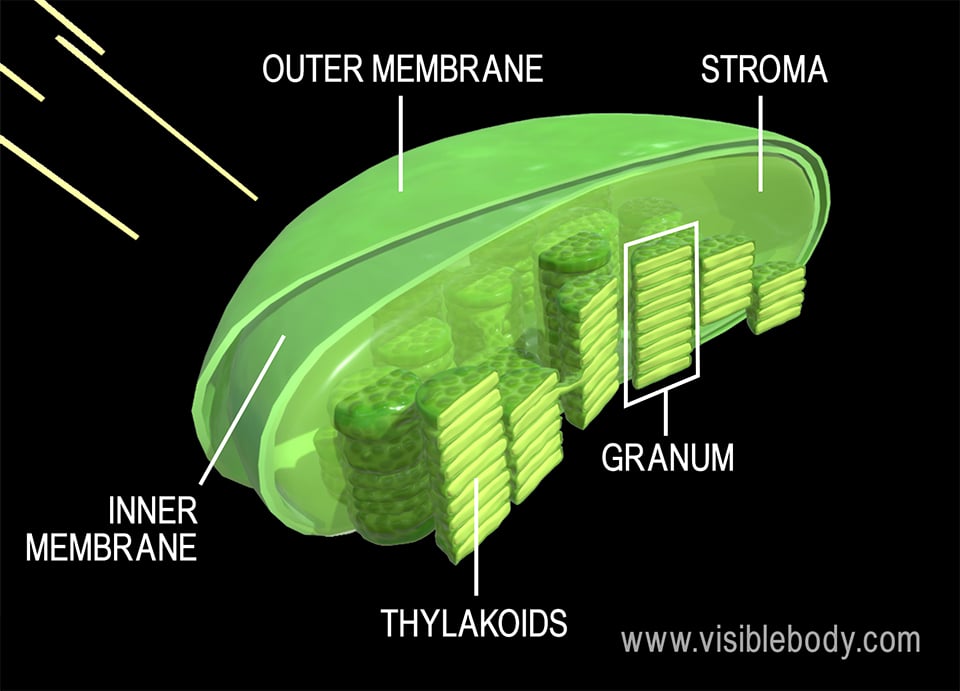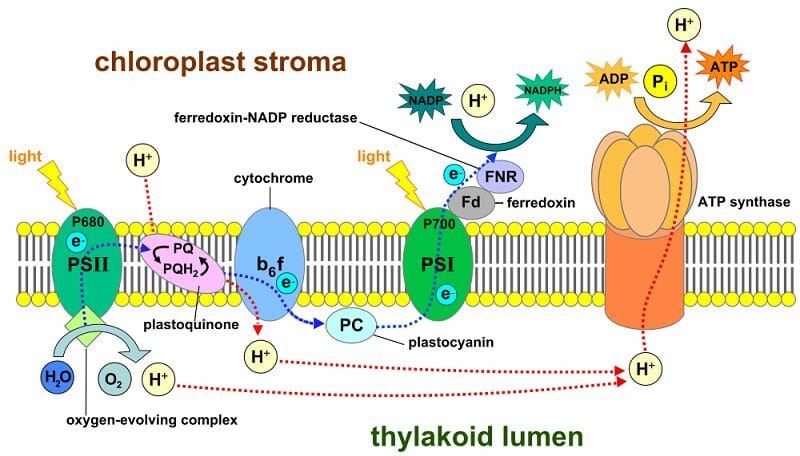Is stroma light dependent? This question delves into the heart of photosynthesis, the process by which plants convert sunlight into energy. The stroma, a gel-like matrix within chloroplasts, is the site of the Calvin cycle, the light-independent reactions of photosynthesis. But is this vital process truly independent of light? Let’s embark on a journey to unravel the intricate relationship between the stroma and light, exploring the dance of energy and molecules that fuels life itself.
The stroma is a bustling hub of activity, packed with enzymes and molecules essential for carbon fixation. Here, carbon dioxide from the atmosphere is transformed into glucose, the building block of life. The Calvin cycle, a series of intricate reactions occurring within the stroma, relies on energy and reducing power supplied by the light-dependent reactions. These reactions, occurring in the thylakoid membranes, harness sunlight to generate ATP and NADPH, the energy currency and electron carrier, respectively.
The flow of these molecules from the thylakoids to the stroma is crucial for the Calvin cycle’s operation, revealing the intricate interdependence of light-dependent and light-independent reactions.
Stroma and its Role in Photosynthesis

The stroma is a thick fluid that fills the chloroplast, the site of photosynthesis in plants. It’s a dynamic environment that plays a crucial role in the conversion of light energy into chemical energy, ultimately fueling life on Earth. The stroma houses the necessary enzymes and molecules for the Calvin cycle, the second stage of photosynthesis, where carbon dioxide is transformed into sugar.
Stroma’s Structure and Location
The stroma is located within the chloroplast, a double-membrane-bound organelle found in plant cells. It surrounds the thylakoid membranes, which are interconnected, flattened sacs that contain chlorophyll, the green pigment essential for capturing light energy. The thylakoid membranes are arranged in stacks called grana, connected by interconnecting lamellae, forming a complex network within the stroma.
Key Enzymes and Molecules in the Stroma
The stroma is teeming with enzymes and molecules that facilitate the Calvin cycle. These include:
- Rubisco: This enzyme is responsible for the initial fixation of carbon dioxide into an organic molecule, a crucial step in the Calvin cycle. It’s one of the most abundant proteins on Earth and plays a pivotal role in the process of photosynthesis.
- Ribulose bisphosphate carboxylase/oxygenase (RuBisCo): This enzyme catalyzes the first step in carbon fixation, the incorporation of carbon dioxide into an organic molecule. It’s the most abundant enzyme on Earth and is crucial for photosynthesis.
- Phosphoribulokinase: This enzyme helps regenerate RuBP, the starting molecule for carbon fixation, ensuring the Calvin cycle continues.
- Glyceraldehyde 3-phosphate dehydrogenase: This enzyme catalyzes the conversion of 3-phosphoglycerate to glyceraldehyde 3-phosphate, a key step in the Calvin cycle.
- ATP and NADPH: These energy-carrying molecules are generated in the light-dependent reactions of photosynthesis and are used in the Calvin cycle to drive the conversion of carbon dioxide into sugar.
Stroma as the Site of Carbon Fixation and Sugar Production
The stroma is the site of carbon fixation, the process of converting inorganic carbon dioxide into organic molecules. This process is driven by the Calvin cycle, a series of enzymatic reactions that use energy from ATP and NADPH produced in the light-dependent reactions.
The Calvin cycle uses carbon dioxide, ATP, and NADPH to produce glucose, a simple sugar that serves as the primary source of energy for most living organisms.
The Calvin cycle involves three main stages:
- Carbon fixation: Carbon dioxide is incorporated into an organic molecule, RuBP, by the enzyme Rubisco.
- Reduction: The resulting molecule is reduced using ATP and NADPH, ultimately forming glyceraldehyde 3-phosphate (G3P), a sugar.
- Regeneration: Some G3P is used to produce glucose, while the rest is used to regenerate RuBP, ensuring the cycle continues.
Light-Dependent Reactions and their Relationship to Stroma

The light-dependent reactions, the first stage of photosynthesis, occur within the thylakoid membranes of chloroplasts. These reactions are directly powered by sunlight, harnessing its energy to create ATP and NADPH, the energy carriers essential for the subsequent Calvin cycle. This intricate process is intimately linked to the stroma, the fluid-filled region surrounding the thylakoids, as it serves as the site for the Calvin cycle and the utilization of the products generated during the light-dependent reactions.
Light Absorption and Energy Conversion
Chlorophyll, the pigment responsible for capturing light energy, resides within the thylakoid membranes. When sunlight strikes a chlorophyll molecule, an electron within the molecule becomes energized and jumps to a higher energy level. This energized electron is then passed along a series of electron carriers embedded in the thylakoid membrane, a process known as the electron transport chain. This chain of electron transfers releases energy, which is used to pump protons (H+) from the stroma into the thylakoid lumen, creating a proton gradient.
ATP and NADPH Production
The proton gradient created across the thylakoid membrane is a source of potential energy. This energy is harnessed by ATP synthase, an enzyme embedded in the thylakoid membrane. As protons flow down their concentration gradient from the thylakoid lumen back into the stroma, ATP synthase utilizes this energy to generate ATP from ADP and inorganic phosphate. Meanwhile, the energized electrons from the electron transport chain are ultimately used to reduce NADP+ to NADPH.
This reduction reaction is catalyzed by the enzyme NADP+ reductase, also located within the thylakoid membrane.
Transport to the Stroma
The ATP and NADPH produced during the light-dependent reactions are crucial for the Calvin cycle, which takes place in the stroma. The thylakoid membrane is permeable to these molecules, allowing them to easily diffuse into the stroma. This transport of energy carriers ensures the smooth transition from the light-dependent reactions to the Calvin cycle, enabling the conversion of carbon dioxide into glucose.
Factors Influencing Stroma Function: Is Stroma Light Dependent

The stroma, the fluid-filled region within chloroplasts, is the site of the Calvin cycle, the light-independent reactions of photosynthesis. This intricate process transforms carbon dioxide into glucose, providing energy for the plant. However, the efficiency of the Calvin cycle is not constant and is significantly influenced by a variety of environmental and internal factors.
Environmental Factors
Environmental factors play a crucial role in regulating the rate of photosynthesis and, consequently, the function of the stroma. These factors include:
- Light Intensity: Light provides the energy for the light-dependent reactions, which generate ATP and NADPH, essential components for the Calvin cycle. Increased light intensity boosts the rate of ATP and NADPH production, accelerating the Calvin cycle. However, excessive light intensity can lead to photoinhibition, damaging the photosynthetic machinery and hindering stroma function.
- Temperature: Enzymes involved in the Calvin cycle have optimal temperature ranges for activity. Within this range, an increase in temperature generally increases the rate of enzymatic reactions, leading to faster carbon fixation. However, temperatures exceeding the optimum can denature enzymes, significantly reducing the efficiency of the Calvin cycle.
- Carbon Dioxide Concentration: Carbon dioxide is the primary substrate for the Calvin cycle. Higher carbon dioxide concentrations increase the rate of carbon fixation, enhancing the production of glucose. Conversely, low carbon dioxide levels limit the rate of the Calvin cycle, impacting the overall photosynthetic efficiency.
pH and Ion Concentration
The pH and ion concentration within the stroma directly influence the activity of enzymes involved in the Calvin cycle.
- pH: The Calvin cycle enzymes have specific pH optima for optimal activity. Fluctuations in pH can disrupt the delicate balance of enzyme activity, affecting the overall efficiency of the Calvin cycle. For example, a decrease in pH can inhibit the activity of Rubisco, the key enzyme in carbon fixation.
- Ion Concentration: The concentration of ions like magnesium (Mg 2+) and potassium (K +) is crucial for the function of several enzymes involved in the Calvin cycle. Mg 2+, for instance, plays a role in the activation of Rubisco, while K + is involved in the regulation of stomatal opening, influencing the availability of carbon dioxide.
Regulatory Mechanisms, Is stroma light dependent
The activity of enzymes and processes within the stroma is meticulously regulated to ensure optimal photosynthetic efficiency. These regulatory mechanisms include:
- Feedback Inhibition: The Calvin cycle is subject to feedback inhibition, where the end product of the cycle, glucose, can inhibit the activity of key enzymes, such as Rubisco. This mechanism prevents the overproduction of glucose and maintains a balanced rate of photosynthesis.
- Enzyme Activation and Deactivation: The activity of enzymes involved in the Calvin cycle can be modulated by phosphorylation, a process that involves the addition of a phosphate group. Phosphorylation can either activate or deactivate an enzyme, depending on the specific enzyme and the cellular conditions.
- Light-Dependent Regulation: The Calvin cycle is directly influenced by the light-dependent reactions. The products of the light-dependent reactions, ATP and NADPH, are essential for the Calvin cycle to proceed. The availability of these energy carriers directly regulates the activity of enzymes and the rate of carbon fixation.
Understanding the relationship between stroma and light is crucial for appreciating the elegance of photosynthesis. The stroma, though seemingly independent, is intricately linked to the light-dependent reactions, relying on their energy and reducing power to fuel the Calvin cycle. This delicate balance ensures the continuous production of glucose, the foundation of life on Earth. As we delve deeper into the mechanisms of photosynthesis, we uncover a symphony of reactions orchestrated by nature’s genius, highlighting the remarkable interplay between light, molecules, and life itself.
Detailed FAQs
What is the role of ATP and NADPH in the Calvin cycle?
ATP provides the energy needed to power the reactions of the Calvin cycle, while NADPH acts as a reducing agent, donating electrons to convert carbon dioxide into sugar.
How does light intensity affect stroma function?
Higher light intensity increases the rate of light-dependent reactions, leading to greater ATP and NADPH production, which in turn stimulates the Calvin cycle and enhances carbon fixation.
Can the Calvin cycle occur in the dark?
While the Calvin cycle is referred to as light-independent, it cannot occur in complete darkness. It requires the products of the light-dependent reactions, ATP and NADPH, which are generated only in the presence of light.
What is the significance of the cyclical nature of photosynthesis?
The cyclical nature of photosynthesis ensures a continuous flow of energy and molecules, allowing for sustained glucose production and the regeneration of the starting molecules for the light-dependent reactions.






